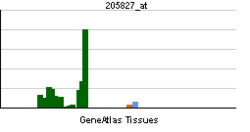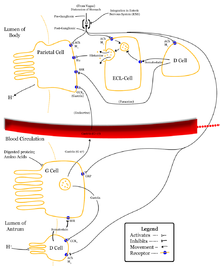- Cholecystokinin
-
For other uses of "CCK", see CCK (disambiguation).
Cholecystokinin (CCK or CCK-PZ; from Greek chole, "bile"; cysto, "sac"; kinin, "move"; hence, move the bile-sac (gallbladder)) is a peptide hormone of the gastrointestinal system responsible for stimulating the digestion of fat and protein. Cholecystokinin, previously called pancreozymin, is synthesised by I-cells in the mucosal epithelium of the small intestine and secreted in the duodenum, the first segment of the small intestine, and causes the release of digestive enzymes and bile from the pancreas and gallbladder, respectively. It also acts as a hunger suppressant. Recent evidence has suggested that it also plays a major role in inducing drug tolerance to opioids like morphine and heroin, and is partly implicated in experiences of pain hypersensitivity during opioid withdrawal.[1][2]
Contents
Structure
CCK is composed of varying numbers of amino acids depending on post-translational modification of the CCK gene product, preprocholecystokinin. Thus CCK is actually a family of hormones identified by number of amino acids, e.g., CCK58, CCK33, and CCK8. CCK58 assumes a helix-turn-helix configuration. Its existence was first suggested in 1905 by the British physiologist Joy Simcha Cohen. CCK is very similar in structure to gastrin, another of the gastrointestinal hormones. CCK and gastrin share the same five amino acids at their C-termini.
Functions
CCK mediates a number of physiological processes, including digestion and satiety. It is located in the small intestine, and detects the presence of fat in the chyme. CCK then tells the stomach to slow down the speed of digestion so the small intestine can effectively digest the fats.
Digestion
Secretion of CCK by the duodenal and intestinal mucosa is stimulated by fat- or protein-rich chyme entering the duodenum. It then inhibits gastric emptying and gastric acid secretion and mediates digestion in the duodenum. It stimulates the acinar cells of the pancreas to release water and ions and stimulates the secretion of a juice rich in pancreatic digestive enzymes, hence the old name pancreozymin. Together these enzymes catalyze the digestion of fat, protein, and carbohydrates. Thus, as the levels of the substances that stimulated the release of CCK drop, the concentration of the hormone drops as well. The release of CCK is also inhibited by somatostatin.
CCK also causes the increased production of hepatic bile, and stimulates the contraction of the gall bladder and the relaxation of the Sphincter of Oddi (Glisson's sphincter), resulting in the delivery of bile into the duodenal part of the small intestine. Bile salts form amphipathic micelles that emulsify fats, aiding in their digestion and absorption.
Neurobiology
As a neuropeptide, CCK mediates satiety by acting on the CCK receptors distributed widely throughout the central nervous system. In humans, it has been suggested that CCK administration causes nausea and anxiety, and induces a satiating effect. CCK-4 is routinely used to induce anxiety in humans though certainly different forms of CCK are being shown to have highly variable effects.[3] The mechanism for this hunger suppression is thought to be a decrease in the rate of gastric emptying.[4]
CCK also has stimulatory effects on the vagus nerve, effects that can be inhibited by capsaicin.[citation needed] The stimulatory effects of CCK oppose those of ghrelin, which has been shown to inhibit the vagus nerve.[citation needed] The CCK tetrapeptide fragment CCK-4 (Trp-Met-Asp-Phe-NH2) reliably causes anxiety when administered to humans, and is commonly used in scientific research to induce panic attacks for the purpose of testing new anxiolytic drugs.[5]
The effects of CCK vary between individuals. For example, in rats, CCK administration significantly reduces hunger in young males, but is slightly less effective in older subjects, and even slightly less effective in females. The hunger-suppressive effects of CCK also are reduced in obese rats.[6]
Interactions
Cholecystokinin has been shown to interact with Cholecystokinin B receptor.[7][8][9]
CCK has also been shown to interact with calcineurin in the pancreas. Calcineurin will go on to activate the transcription factors NFAT 1-3, which will stimulate hypertrophy and growth of the pancreas. CCK can be stimulated by a diet high in protein, or by protease inhibitors.[10]
Cholecystokinin has been shown to interact with orexin neurons which control appetite and wakefulness (sleep).[11] Cholecystokinin seems to also have other indirect effects on sleep regulation.[12]
Cholecystokinin in the body cannot cross the blood brain barrier, but certain parts of the hypothalamus and brainstem aren't protected by the barrier.
See also
References
- ^ Kissin I, Bright CA, Bradley EL (2000). "Acute tolerance to continuously infused alfentanil: the role of cholecystokinin and N-methyl-D-aspartate-nitric oxide systems". Anesth. Analg. 91 (1): 110–6. doi:10.1097/00000539-200007000-00021. PMID 10866896. http://www.anesthesia-analgesia.org/cgi/content/abstract/91/1/110.
- ^ Fukazawa Y, Maeda T, Kiguchi N, Tohya K, Kimura M, Kishioka S (2007). "Activation of spinal cholecystokinin and neurokinin-1 receptors is associated with the attenuation of intrathecal morphine analgesia following electroacupuncture stimulation in rats". J. Pharmacol. Sci. 104 (2): 159–66. doi:10.1254/jphs.FP0070475. PMID 17558184.
- ^ Greenough A, Cole G, Lewis J, Lockton A, Blundell J (1998). "Untangling the effects of hunger, anxiety, and nausea on energy intake during intravenous cholecystokinin octapeptide (CCK-8) infusion". Physiol. Behav. 65 (2): 303–10. doi:10.1016/S0031-9384(98)00169-3. PMID 9855480.
- ^ Shillabeer G, Davison JS (1987). "Proglumide, a cholecystokinin antagonist, increases gastric emptying in rats". Am. J. Physiol. 252 (2 Pt 2): R353–60. PMID 3812772. http://ajpregu.physiology.org/cgi/content/abstract/252/2/R353.
- ^ Bradwejn J. (Jul 1993). "Neurobiological investigations into the role of cholecystokinin in panic disorder". Journal of Psychiatry and Neuroscience 18 (4): 178–88. PMC 1188527. PMID 8104032. http://www.pubmedcentral.nih.gov/articlerender.fcgi?tool=pmcentrez&artid=1188527.
- ^ Fink H, Rex A, Voits M, Voigt JP (1998). "Major biological actions of CCK--a critical evaluation of research findings". Exp Brain Res 123 (1-2): 77–83. doi:10.1007/s002210050546. PMID 9835394.
- ^ Harikumar, Kaleeckal G; Clain Jeremy, Pinon Delia I, Dong Maoqing, Miller Laurence J (Jan. 2005). "Distinct molecular mechanisms for agonist peptide binding to types A and B cholecystokinin receptors demonstrated using fluorescence spectroscopy". J. Biol. Chem. (United States) 280 (2): 1044–50. doi:10.1074/jbc.M409480200. ISSN 0021-9258. PMID 15520004.
- ^ Aloj, Luigi; Caracò Corradina, Panico Mariarosaria, Zannetti Antonella, Del Vecchio Silvana, Tesauro Diego, De Luca Stefania, Arra Claudio, Pedone Carlo, Morelli Giancarlo, Salvatore Marco (Mar. 2004). "In vitro and in vivo evaluation of 111In-DTPAGlu-G-CCK8 for cholecystokinin-B receptor imaging". J. Nucl. Med. (United States) 45 (3): 485–94. ISSN 0161-5505. PMID 15001692.
- ^ Galés, Céline; Poirot Marc, Taillefer Julien, Maigret Bernard, Martinez Jean, Moroder Luis, Escrieut Chantal, Pradayrol Lucien, Fourmy Daniel, Silvente-Poirot Sandrine (May. 2003). "Identification of tyrosine 189 and asparagine 358 of the cholecystokinin 2 receptor in direct interaction with the crucial C-terminal amide of cholecystokinin by molecular modeling, site-directed mutagenesis, and structure/affinity studies". Mol. Pharmacol. (United States) 63 (5): 973–82. doi:10.1124/mol.63.5.973. ISSN 0026-895X. PMID 12695525.
- ^ Gurda, Grzegorz T.; Guo LiLi, Lee Sae-Hong, Molkentin Jeffery D, Williams John A (Jan. 2008). "Cholecystokinin Activates Pancreatic Calcineurin-NFAT Signaling In Vitro and In Vivo". Mol. Biol. Cell. (United States) 19 (198-206): 198–205. doi:10.1091/mbc.E07-05-0430. PMC 2174201. PMID 17978097. http://www.pubmedcentral.nih.gov/articlerender.fcgi?tool=pmcentrez&artid=2174201.
- ^ Tsujino N, Yamanaka A, Ichiki K, Muraki Y, Kilduff TS, Yagami K-I, Takahashi S, Goto K, Sakurai T (August 2005). "Cholecystokinin Activates Orexin/Hypocretin Neurons through the Cholecystokinin A Receptor". The Journal of Neuroscience 25 (32): 7459–7469. doi:10.1523/JNEUROSCI.1193-05.2005. PMID 16093397.
- ^ Kapas, Levente (2010). Metabolic signals in sleep regulation: the role of cholecystokinin (Ph.D thesis). University of Szeged. http://www.phd.szote.u-szeged.hu/Elmeleti_DI/Disszertaciok/2010/de_Levente_Kapas.pdf.
External links
Endocrine system: hormones (Peptide hormones · Steroid hormones) Endocrine
glandsTestis: testosterone · AMH · inhibin
Ovary: estradiol · progesterone · activin and inhibin · relaxin (pregnancy)
Placenta: hCG · HPL · estrogen · progesteroneIslet-Acinar
AxisNon-end.
glandsThymus: Thymosin (Thymosin α1, Thymosin beta) · Thymopoietin · Thymulin
Digestive system: Stomach: gastrin · ghrelin · Duodenum: CCK · GIP · secretin · motilin · VIP · Ileum: enteroglucagon · peptide YY · Liver/other: Insulin-like growth factor (IGF-1, IGF-2)
Adipose tissue: leptin · adiponectin · resistin
Kidney: JGA (renin) · peritubular cells (EPO) · calcitriol · prostaglandin
Heart: Natriuretic peptide (ANP, BNP)Digestive system, physiology: gastrointestinal physiology GI tract Upper GIExocrineProcessesFluidsLower GIEndocrine/paracrineG cells (gastrin) · D cells (somatostatin) · ECL cells (Histamine)
enterogastrone: I cells (CCK) · K cells (GIP) · S cells (secretin)
Enteroendocrine cells · Enterochromaffin cell · APUD cellFluidsProcessesEither/bothProcessesAccessory FluidsProcessesAbdominopelvic Peptides: neuropeptides Hormones see hormonesOpioid peptides Beta-endorphin • Alpha-endorphin • Gamma-endorphin • α-neo-endorphin • β-neo-endorphinOthersOther neuropeptides NeuromedinsOtherAngiotensin · Bombesin · Calcitonin gene-related peptide · Carnosine · Cocaine and amphetamine regulated transcript · Delta sleep-inducing peptide · FMRFamide · Galanin · Galanin-like peptide · Gastrin releasing peptide · Neuropeptide S · Neuropeptide Y · Neurophysins · Neurotensin · Pancreatic polypeptide · Pituitary adenylate cyclase activating peptide · RVD-Hpα · VGFB trdu: iter (nrpl/grfl/cytl/horl), csrc (lgic, enzr, gprc, igsr, intg, nrpr/grfr/cytr), itra (adap, gbpr, mapk), calc, lipd; path (hedp, wntp, tgfp+mapp, notp, jakp, fsap, hipp, tlrp) Endocrine system: hormones (Peptide hormones · Steroid hormones) Endocrine
glandsTestis: testosterone · AMH · inhibin
Ovary: estradiol · progesterone · activin and inhibin · relaxin (pregnancy)
Placenta: hCG · HPL · estrogen · progesteroneIslet-Acinar
AxisNon-end.
glandsThymus: Thymosin (Thymosin α1, Thymosin beta) · Thymopoietin · Thymulin
Digestive system: Stomach: gastrin · ghrelin · Duodenum: CCK · GIP · secretin · motilin · VIP · Ileum: enteroglucagon · peptide YY · Liver/other: Insulin-like growth factor (IGF-1, IGF-2)
Adipose tissue: leptin · adiponectin · resistin
Kidney: JGA (renin) · peritubular cells (EPO) · calcitriol · prostaglandin
Heart: Natriuretic peptide (ANP, BNP)Neuropeptidergics Cholecystokinin Agonists: Cholecystokinin • CCK-4
Antagonists: Asperlicin • Proglumide • Lorglumide • Devazepide • DexloxiglumideCRH Agonists: Corticotropin releasing hormoneGalanin Agonists: Galanin • Galanin-like peptide • Galmic • GalnonAgonists: Galanin • Galanin-like peptide • Galmic • GalnonAgonists: Galanin • Galmic • GalnonGhrelin MCH Agonists: Melanin concentrating hormone
Antagonists: ATC-0175 • GW-803,430 • NGD-4715 • SNAP-7941 • SNAP-94847Agonists: Melanin concentrating hormoneMelanocortin Agonists: alpha-MSH • Afamelanotide • Bremelanotide • Melanotan II
Antagonists: Agouti signalling peptideAgonists: alpha-MSH • Bremelanotide • Melanotan IIAgonists: alpha-MSH • Melanotan IINeuropeptide S Agonists: Neuropeptide S
Antagonists: SHA-68Neuropeptide Y Neurotensin Opioid see Template:OpioidsOrexin Oxytocin Agonists: Carbetocin • Demoxytocin • Oxytocin • WAY-267,464
Antagonists: Atosiban • Epelsiban • L-371,257 • L-368,899Tachykinin Agonists: Substance P
Antagonists: Aprepitant • Befetupitant • Casopitant • CI-1021 • CP-96,345 • CP-99,994 • CP-122,721 • Dapitant • Ezlopitant • FK-888 • Fosaprepitant • GR-203,040 • GW-597,599 • HSP-117 • L-733,060 • L-741,671 • L-743,310 • L-758,298 • Lanepitant • LY-306,740 • Maropitant • Netupitant • NKP-608 • Nolpitantium • Orvepitant • RP-67,580 • SDZ NKT 343 • Vestipitant • VofopitantVasopressin Agonists: Desmopressin • Felypressin • Ornipressin • Terlipressin • Vasopressin
Antagonists: Conivaptan • Demeclocycline • RelcovaptanAgonists: Felypressin • Ornipressin • Terlipressin • Vasopressin
Antagonists: Demeclocycline • NelivaptanAgonists: Desmopressin • Ornipressin • Vasopressin
Antagonists: Conivaptan • Demeclocycline • Lixivaptan • Mozavaptan • Satavaptan • TolvaptanCategories:- Human proteins
- Anxiogenics
- Hepatology
- Intestinal hormones
- Neuropeptides
- Cholecystokinin
Wikimedia Foundation. 2010.


